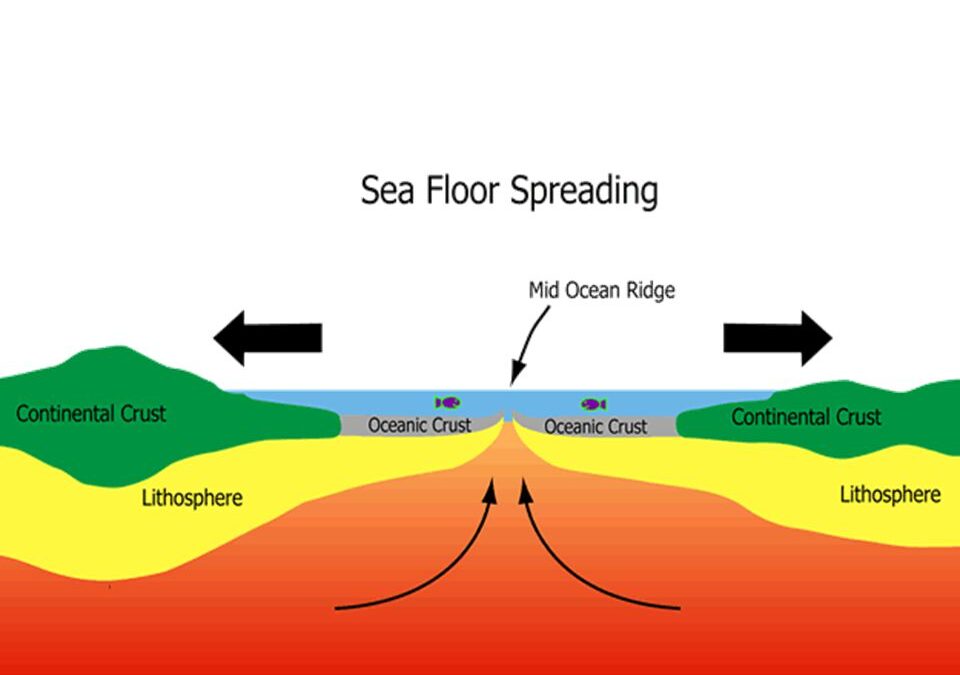A lot of people ask about which of the following correctly describes seafloor spreading. Seafloor spreading is a process that will occur at the ridges of the mid-ocean. It is the new oceanic crust that forms through volcano eruption and after some time they move away from the ridge. This theory revolutionized geologic thought during the last quarter of the 20th century.
Which of the Following Correctly Describes Seafloor Spreading?
Seafloor spreading is a type of geological process in which the lithosphere separate from each other. It will occur at divergent plate boundaries. This hypothesis was proposed by the American geophysicist Harry H. Hess in 1960. It helps to explain perfectly continental drift when the plates present in the earth became divergent tensionally. The stress caused to break in the lithosphere.
Hess discovered that the oceans were lower in the middle and recognized the existence of mountains in the Mediterranean Sea, rising to 1.5 km above the surface of the entire ocean floor (outside the depths). This created a new sea, which then stretched on both sides.
Also Read: Which of the Following Factors is Least influential in Affecting the Biodiversity of Wetlands?
Which of the Following Correctly Describes Seafloor Spreading? Step of Seafloor Spreading:
- Magma reaches out of the rift valley
- Magma became cool and became hard and covert to the rock
- Rock is separated as build a new rock at the MOR
- Oceanic crust and continental crust join at the place of the trench.
- Oceanic crust folded beneath the continental crust
- Gravity pulls rock towards the mantle.
- Finally, the old ocean floor is pushed out from under the continental plate and melts back into magma.
How is a volcanic Activity connected to Seafloor Spreading?
In different oceans, volcanoes erupt with the cracks that are opened in the floor of the ocean. It is due to the separating of two plates called a mid-ocean ridge. Magma present under the earth comes up the mantle and fills these large cracks. This new oceanic lithosphere cools down and contracts by up to 3% of its volume.
Also Read: Which of the following Behavior Patterns may be Characteristics of Minors?
In many simulations, the geologist gives the result that the young lithosphere is contracted. In very low cases in the ridge with parallel direction. This happens almost a quarter of the time. The young oceanic lithosphere can be contracted more freely in the direction where they spread.
There are Mainly three Types of Proof from which we have an idea about Seafloor Spreading that Are:
- Molten material
- Magnetic stripes
- Drilling samples
This evidence is proved by the HESS theory.
How Seafloor can Affect Continents:
- It will produce major features related to seafloor which are
- The age of seafloor is going to be older away from the ridges of mid-ocean
- The height of the seafloor is going to be lower away from the ridges of the mid-ocean
- The history of the seafloor will be the striped pattern of the Earth’s magnetic
Seafloor Spreading Evidence:
- Age of the rock
- Rock at the time of ridges=At the young stage
- Rock at the time of trenches=At the older stage
- The rocks get older now
Seafloor spreading is important as it is building rifts and the crust under most of the Ocean. It is leaving a pattern of older crust also helps explain continental drift in the theory of plate tectonics.
Which of the Following Correctly Describes Seafloor Spreading? Disadvantages of Seafloor Spreading:
With many advantages, seafloor spreading also has some disgusting effects that can highly influence the sea level. As the oceanic crust separated from the shallow ocean ridges when it became cool it will become thinner and weaker than before. After all these effects the volume of the ocean increases and the sea level became low and decreases its volume.
This situation can also be caused by earthquakes and create many problems for living things. For example, it can take many people and animals’ lives and can also destroy their property.

